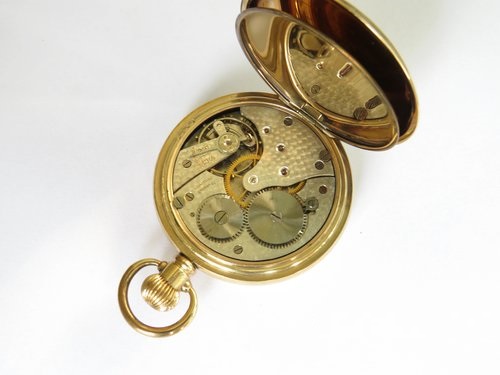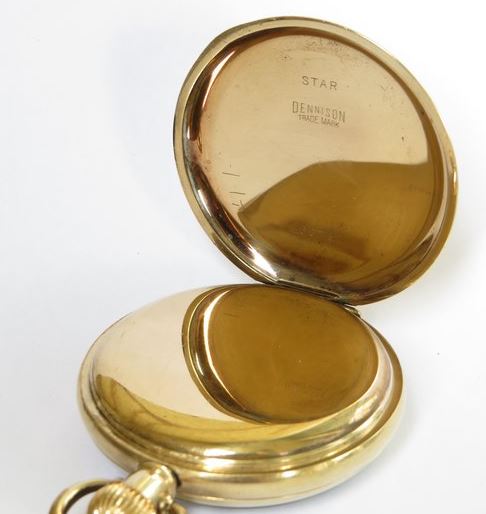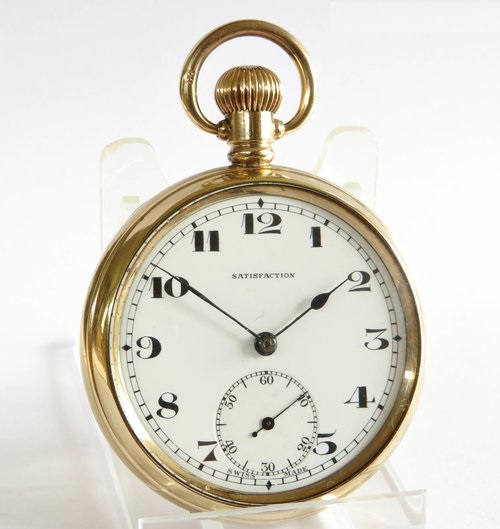Last updated on May 7, 2024
I am always looking to add to my collection however as time rolls on I find myself becoming fussier with my selections. I am always looking to buy an antique watch that adds something different to my collection. Typically, I am looking for a high-quality watch from different Swiss or English manufacturers. I enjoy researching the watches as much as I enjoy wearing them. In this instance, this antique Satisfaction pocket watch caught my attention because it was made by an obscure watchmaker with a reputation for producing good quality lever movements.
The manufacturer in question was L. Tièche-Gammeter who was later acquired by Meyer & Studeli SA. As per the other antique watches in my collection, it has to be presentable and reliable enough for practical use. As I removed it from the bubble wrap I could see that it was in immaculate condition and it now sits ticking in front of me at the beginning of a twenty-four hour timekeeping trial.
Movement
The watch has a Swiss made 15-jewel stem-winding movement which is working well. In antique watches, 15-jewel movements are considered ‘fully jewelled’ and is an indication of quality. Although I have had some 7-jewel watches in my collection, I generally try and collect watches with a minimum of 15-jewels. The movement is protected by an inner hinged cover which has a few scratches from where it has been opened in the past. These scratches are not visible during the day to day use and don’t detract from the piece at all. I would consider this to be patina rather than damage.
L. Tièche-Gammeter
The dial is signed Satisfaction, which is a brand name registered by the manufacturer L. Tièche-Gammeter (LTG) in 1909. The company was based in Solothurn in Switzerland. There is very little information online regarding LTG. It was known as a reputable business producing high-quality lever escapements. It registered several brands, Satisfaction, Roamer (1908) and Tiega (1903). Apparently, it also won several medals competing in international exhibitions. I couldn’t find any reference as to what these medals were or when the company was founded.
The company was acquired by Meyer & Studeli in 1917. Meyer & Studeli were successful producers of lower quality watches made with inferior cylinder movements. The purchase of LTG quite possibly gave Meyer & Studeli access to higher quality lever movements and allowed them to use brand names with a better reputation. Meyer & Studeli continued to produce Satisfaction branded watches during the 1920s and 30s. The later Satisfaction watches all had a clear LTG makers mark on the movement. This watch doesn’t so, I am going to date this watch to pre-Meyer & Studeli ownership of the LTG brand. In 1952, Meyer & Studeli changed the company name to Roamer, which is still in existence today.
The Dennison Watch Case Company
Aaron Lufkin Dennison (1812 – 1895) was an American-born businessman. He trained as a watchmaker and had a long career in the watchmaking industry. Dennison worked for several watchmaking companies, including one that was to eventually become the Waltham Watch Company. In 1864, Dennison founded the Tremont Watch Company in Boston. He intended to use imported components from Swiss manufacturers because labour costs were lower. Dennison left a business partner in charge in Boston and migrated to Switzerland to oversee operations. The Tremont Watch Company fell into financial difficulties in 1870. As a result, Dennison moved to England. In 1874, he founded the very successful Dennison Watch Case Company in Birmingham. Dennison supplied many watch manufacturers with cases made from a variety of materials.
The business began in a small workshop alongside the family home. Originally, the company was called Dennison, Wigley & Company and it grew to produce 100,000 high-quality watch cases per year. When Dennison died in 1895, the business was taken over by his son, Franklin Dennison. The company was renamed the Dennison Watch Case Company Ltd in 1905 and continued as a successful business until 1967.
Case condition
The case for the Satisfaction pocket watch is the Dennison Star model. This is a 9-carat gold filled case guaranteed to last ten years, as stated on the inner dust cover. The inside of the Star case, which naturally was subject to less wear, was electroplated with a gold plate to reduce costs. The case is in excellent condition without any dents and with no sign of the underlying base metal. It certainly has exceeded its ten-year guarantee. The case measures 50mm diameter excluding the winding stem and the loop.
Crystal and dial
The original watch glass is in excellent condition. No markings are visible, even under magnification.
The enamel dial is signed Satisfaction, the lettering remains crisp and clear. The dial looks good to the naked eye. There are a couple of minor blemishes visible under magnification, these are very short faint hairlines beneath the subsidiary seconds dial. The hands are original and are made from blued steel. Bluing steel is a process that creates an oxidised coating that prevents corrosion. First, the hands are cleaned and polished. Next, the hands are heated, over a bed of brass filings, to a high temperature. The layer of brass filings is used to maintain a stable temperature. The steel changes colour from gold to brown and then purple before it acquires its final blue colouring.
Antique Satisfaction pocket watch, c1910
I guess I can say that I am extremely ‘satisfied’ with my antique Satisfaction pocket watch. It is a very presentable timepiece, with perhaps the cleanest case of those that have passed through my collection. It is also a practical timepiece. The watch passed the 24-hour accuracy-test running at approximately 90 seconds fast. This is more than acceptable for a watch that is over a hundred years old. The power reserve was just over 32 hours on a full wind, which is excellent for an antique pocket watch. I enjoyed researching about the reputable, but obscure manufacturer, L. Tièche-Gammeter (LTG). I look forward to an occasion when I can wear this antique pocket watch.




I have a near identical Satisfaction pocket watch which has been passed down through the family from my great great grandfather, it would date from around the same time as the watch on the post. It has been sitting in a box for decades. Is it safe to wind it? As a family heirloom, I don’t want to damage it. Can you advise on what should I do?
Hi Archie, The lubricants in your Coventry Astral pocket watch would have dried out decades ago and you could cause damage if you wind it. The best thing to do is to get it serviced. They will strip down the watch, clean all of the components, lubricate them, reassemble and regulate the time. Servicing is around £125 at the time of writing, but could be more if replacement parts are required. There is a list of accredited repairers at the British Horological Institute. Other countries will have similar organisations. It is worth getting it serviced for future generations to enjoy. Keep in mind that modern lubricants last about ten years, so this is probably the frequency of servicing, winding it monthly will help circulate the lubricants. Most importantly, make sure you wear and enjoy your Coventry Astral pocket watch. Thanks for commenting, Jason.
I have a small LTC ladies watch 32mm case. this company is prety obscure and difficult to research. it has a signed 1 jewel cylinder escapement and I suspect the signed case is solid gold but has no halmarks except the company name. very nice quality little watch.
Thank you for this information on my ‘Satisfaction’ 10 jewel pocket watch. Recently purchased for $25 gpb. Runs well. I do not see any markings other than a “17” on one of the plates. I am going to assume it is one of the earlier watches.